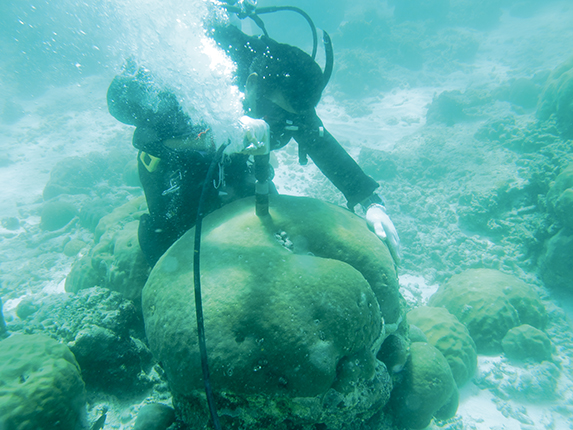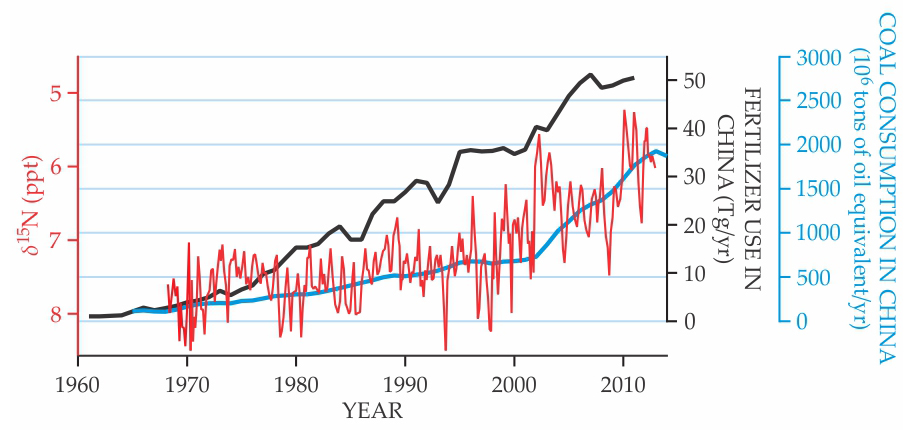Coral isotopes track the rise of anthropogenic nitrogen
DOI: 10.1063/PT.3.3614
Nitrogen is critical to life on Earth: Every amino acid of every protein molecule in every living thing contains at least one N atom. The N2 molecules that make up most of the atmosphere, however, are nearly inert, and the element must be converted into some other chemical form before organisms can use it. That conversion can be accomplished in a few ways: lightning; N fixation by various species of bacteria and algae; and, more recently, industrial synthesis of ammonia for fertilizer. Fossil-fuel combustion, too, adds to the supply of chemically available N by releasing organic material from long-dead organisms previously trapped underground.
Human activities are known to have a sizeable and deleterious effect on the global N cycle. (See the article by Ann Kinzig and Robert Socolow, Physics Today, November 1994, page 24
But the geographic extent of the disruption is poorly understood because data on the N cycle from before the rise of pollution are sparse, particularly from remote areas. Now National Taiwan University’s Haojia Ren and her colleagues have used isotope measurements to derive a 45-year N record from the coral reefs of Dongsha Atoll, an uninhabited group of islands in the South China Sea, 340 km from land. 1 Not only did the researchers detect a clear increase in anthropogenic N taken up by the coral, but they were also able to pinpoint the increase precisely enough in time to correlate it with the recent changes in Chinese pollution levels.
Heavy nitrogen
Corals, such as the one in figure

Figure 1. To collect a cylindrical coral sample, 3 cm across and tens of centimeters long, Kan-Min of the Dongsha Atoll Research Station drills into a large coral colony. The pneumatic drill is powered by a spare scuba tank.
THOMAS DECARLO

Because the old exoskeletons in the interior of a coral colony are devoid of living tissue, they remain largely unchanged from the time when their long-dead polyps were alive. Like tree rings and human hair, therefore, corals offer valuable records of conditions over the course of their growth. Though mostly calcium carbonate, the exoskeletons contain a small amount of N-containing protein.
There’s no evidence that anthropogenic pollution has a measurable effect on the total amount of N assimilated by corals. But it does potentially affect that N’s isotopic composition. Natural N samples are made up of two stable isotopes: 99.6% 14N and 0.4% 15N. Physical and chemical processes can alter that composition a bit—by a few parts per thousand relative to the amount of 15N—by favoring one isotope or the other.
The deep-sea N that naturally feeds marine organisms is enriched in 15N, because the processes that remove N from the ocean have a preference for the lighter 14N. On the other hand, anthropogenic sources—both fossil fuels and fertilizers—have a 15N fraction slightly smaller than that of air. If N pollution is making its way into the open ocean, it would manifest as a drop in the 15N abundance over time.
The challenge lies in measuring that drop. By weight, coral skeletal material is about 0.1% protein, protein is 20% N, N is 0.4% 15N, and the abundance of 15N varies by at most a fraction of a percent. A gram of coral, then, contains less than a microgram of 15N, which must be detected with better than nanogram precision.
Isotope-ratio mass spectrometry can do that, provided that the protein can be extracted from the CaCO3 skeleton and the N can be converted to a uniform chemical form. Efforts to study coral N in the mid 2000s used separation techniques—osmosis through a membrane, filtration, or combustion—that required impractically large coral samples and offered poor precision. 2
In 2015 Princeton University’s Daniel Sigman (Ren’s PhD adviser and a coauthor on the new paper) and his colleagues developed a new method for extracting N from coral. With it, they were able to make precise 15N measurements with just 5 mg of exoskeletal material. 3 The process comprises a series of chemical steps culminating with Sigman’s so-called denitrifier method, which uses specially cultured bacteria to convert the N from nitrate to nitrous oxide. 4 As a gas, the N2O is easy to collect and isotopically analyze.
Open ocean
Not long after she started working in Taiwan in 2012, Ren got the idea to use coral N to test the spread of pollution to Dongsha Atoll. Though administered as a national park by the government of Taiwan, Dongsha is not open to tourists, and human presence on the islands is minimal.
Situated among mainland China to the northwest, Taiwan to the northeast, and the Philippines to the southeast, Dongsha is less remote than some oceanic islands. But it’s sufficiently distant from its neighbors that it’s isolated from their coastal waters. The only way anthropogenic emissions can reach it is via the air.
Fossil-fuel combustion releases N into the atmosphere in the form of various oxides, collectively known as NOx. Fertilizers, when they break down, are the main source of atmospheric ammonia. Right now, China produces plenty of both. But crucially, 50 years ago it didn’t. A decades-long coral record therefore offers a comparison between the N conditions in the present day and a time when nearly all the available N was natural.
To ensure a sufficiently long record, Ren’s team collected 20 coral cores from colonies around the atoll. As coauthor Thomas DeCarlo explains, sampling is conducted with an eye toward the coral’s long-term health. “After removing a core, we plug the hole with cement and seal it with epoxy so the corals can grow back,” he says, “and we keep tabs on their recovery. We’ve never seen a colony die as a result of drilling.”
Though one of their cores dated back 60 years, Ren and colleagues chose for their analysis a core that covered a somewhat shorter time span. That coral grew faster, says Ren, “and the high growing rate allowed us to analyze it with better time resolution.”
The results of the isotopic measurements, performed in Sigman’s lab, are plotted in red in figure

Figure 2. As nitrogen emissions from China have increased, so has their influence on Dongsha Atoll. The coral-derived record of the relative 15N abundance δ15N (red), normalized to air exhibits a change in slope around the year 2000, as does the annual coal consumption (blue) but not the annual fertilizer use (black). (Adapted from ref.

Also curious is the timing of the change: beginning around the year 2000. Fertilizer and coal use in China have both grown in recent decades, as figure
The results hint that switching from coal to cleaner fuels that emit less NOx could mitigate the impact on the open ocean, but it’s hard to draw definitive conclusions from measurements at a single location. Ren and her colleagues are working toward extending their measurements to other coral reefs around the world, which are numerous in tropical and subtropical waters. “Dongsha is special because it’s a hot spot for recent growth in anthropogenic atmospheric nitrogen,” Ren explains. “Now that we’ve proved that we can detect this signal, the next obvious thing to do is to look for it in other places.”
References
1. H. Ren et al., Science 356, 749 (2017). https://doi.org/10.1126/science.aal3869
2. L. Muscatine et al., Proc. Natl. Acad. Sci. USA 102, 1525 (2005);https://doi.org/10.1073/pnas.0408921102
G. Marion et al., Mar. Pollut. Bull. 50, 931 (2005). https://doi.org/10.1016/j.marpolbul.2005.04.0013. X. T. Wang et al., Geochim. Cosmochim. Acta 148, 179 (2015). https://doi.org/10.1016/j.gca.2014.09.017
4. D. M. Sigman et al., Anal. Chem. 73, 4145 (2001). https://doi.org/10.1021/ac010088e
